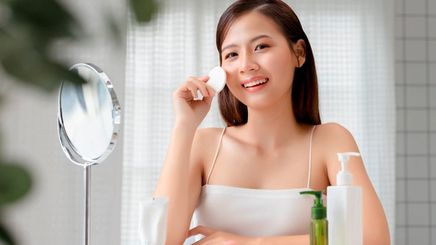
Did you know that your old skin cells make up of the dust in your home? It’s true – your skin is constantly shedding and renewing itself every day. However, the process can slow down as you age, which is where chemical exfoliants come to the rescue. They pack more power than their physical counterparts and can help you win the battle against various issues, from acne to .
Before you use , it’s important to inspect the main ingredients because some may be too harsh for first-timers. The last thing you want is from bad reactions.
So, whether you have dry or oily skin (or somewhere in between), keep scrolling to find a lineup of the most beginner-friendly chemical exfoliants suitable for every skin type. Plus, read tips on how to use acids in skincare for the best results.
Types of Chemical Exfoliants
There are three main categories of acids used in : alpha hydroxy acids (AHAs), beta hydroxy acids (BHA), and . One of the main differences between the three is their molecular size and solubility.
AHAs are water-soluble and typically come in smaller molecules, allowing them to penetrate deeper into the pores. In contrast, BHAs are a match for those dealing with oily T-zone since they’re oil-soluble. PHAs, on the other hand, have larger molecule structures than their two siblings, which makes them compatible with nearly all .
Now that you know the basics, let’s break down the star players of each group.
Gluconolactone is ideal for sensitive skin.
If it’s your first foray into chemical exfoliants and your skin is notably reactive, gluconolactone should be on your radar. This PHA dissolves dead cells on the outermost layer of your skin without causing peeling or inflammation. Its benefits don't stop at skin brightening and smoothing out texture. Gluconolactone’s hydrating properties also make it suitable for dry skin conditions like and rosacea.
Lactobionic acid is packed with antioxidants.
Another standout from the PHA family is lactobionic acid (LA). It works similarly to gluconolactone in terms of exfoliating, only it’s twice as hydrating and rich in antioxidants. According to one study, LA helps maintain by absorbing from UV radiation and pollution. This translates into a more radiant, resilient, and younger-looking complexion.
Give the multi-tasking glycolic acid a go.
Jennifer Lopez credited her glowing and clear skin to , so you know it deserves a spot on your .
Among all the AHAs, glycolic acid has the simplest and smallest molecular structure. It does more than exfoliate dead skin cells since it can easily penetrate the deeper layer of the skin. Multiple studies have reported its ability to stimulate . By doing so, glycolic acid helps improve skin firmness and minimize .
Lactic acid helps regulate your skin microbiome.
In ancient times, Cleopatra famously bathed in sour milk to reap the benefits of lactic acid – a type of AHA derived from fermented lactose. The good news is you don’t need to follow in her footsteps since you can easily find chemical exfoliants containing this ingredient in the market.
Lactic acid is milder but just as mighty as glycolic acid. What makes it extra unique is it doubles as a humectant, meaning it draws moisture into the skin. But that’s not all. Lactic acid also boasts , meaning it encourages the presence of all while fighting off the “bad” ones
Bust acne with salicylic acid.
Retire your because you can get rid of pesky zits minus the pain and scarring by using . This popular BHA reaches down to the lipid layers of the skin, clearing out sebum and debris clogging the pores, which . During the process, it also loosens blackheads, calms redness, and helps control oil production.
When Should I Use Chemical Exfoliant?
It depends on your skin tolerance and the concentration of acids in the exfoliant. Experts agree that you shouldn’t use it more than two to three times a week. For newbies, it’s best to apply it once weekly to let the skin adjust. Then, you can gradually increase the frequency if your skin responds well and doesn't show .
How you use chemical exfoliants matters, too. No matter which kind you choose, the key is keeping your skin’s hydration levels balanced.
Before exfoliation, wash your face with Dove Facial Cleansing Mousse Moisture Care to remove makeup and other impurities. The gentle formula has 40% Active-Boost serum and , which helps replenish lost moisture and fortify the skin barrier.
Next, use the exfoliant as instructed in the packaging. Wait a few minutes until the ingredients are fully absorbed into the skin. Finish your skincare routine with a dollop of POND'S Bright Miracle Day Cream. It contains for a boost of hydration and niasorcinol to promote brighter, even toned skin.
Chemical exfoliants are a great ally when it comes to restoring . Just remember that moderation is key. Overdoing them might end up doing more harm than good. Hit up your dermatologist if you notice your skin becomes red, itchy, or even painful after exfoliation.